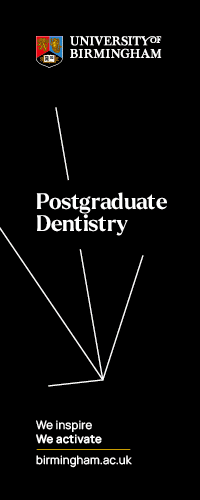European Journal of Prosthodontics and Restorative Dentistry
Evaluation of the Internal and Marginal Discrepancies of Co-Cr Metal Copings Prepared via CAD/CAM and Conventional Casting
Abstract
European Journal of Prosthodontics and Restorative Dentistry (2019) 27, 26–31
Keywords
Computer-Aided Design
Alloys
Computer-Aided Manufacture
Marginal Discrepancy
Internal Discrepancy
ABSTRACT
The aim of this study was to assess the internal and marginal discrepancies of chromium-cobalt (Co/Cr) copings fabricated using different techniques. A typodont molar
tooth was prepared and replicated in die stone and scanned. Forty Co-Cr alloy copings
were produced using four different production techniques: conventional casting (Cgroup), direct metal laser sintering (DMLS-group), micro-stereolithography/casting
combination (µSLA-group), and computer-aided milling (M-group) (n = 10). The internal
and marginal discrepancies at various reference points were determined via digital microscopy. Analysis of variance (ANOVA) and Tukey’s multiple comparisons tests were
used for statistical analysis (p=0.05). The marginal and cervical discrepancies of the
C-group were similar to those of the M-group (p>0.05) and better than those of the
µSLA-group (p<0.05). The marginal and internal discrepancies of all groups were within
clinically acceptable limits, but further improvements in the µSLA and DMLS techniques
may be required prior to clinical implementation.
rbe
Authors
Dr. Suleyman Cagatay Dayan§
(DDS, PhD)
Dr. Burim Kiseri^
Ba
(DDS, PhD)
Dr. Burc Gencel§
(DDS, PhD)
Dr. Aysegul Kurt*
Address for Correspondence
Email: [email protected]
nn
Dr. Aysegul Kurt*
is
(DDS, PhD)
* Trakya University, Faculty of Dentistry,
Department of Prosthodontics, Edirne, Turkey
Program of Dental Technicians, Istanbul
University, Istanbul, Turkey
De
§
rL
td
Evaluation of the Internal
and Marginal Discrepancies
of Co-Cr Metal Copings
Prepared via CAD/CAM and
Conventional Casting
©
^ Department of Prosthodontics, UBT College,
Faculty of Dentistry, Pristina, Kosovo
INTRODUCTION
Conventional metal ceramic restorations have been used to prepare
fixed prostheses for several decades and afford satisfactory clinical outcomes;1,2 thus, they remain the primary treatment choice in most cases.
Basically, a ceramic material is fused to a metal substructure prepared
either via casting or digitally enhanced metal-ceramic restoration.
The basic procedure for conventional casting is as follows: the invested
wax pattern of the substructure is burnt out to create a heat-resistant
chamber receiving a melted alloy to complete the casting.3 This method is
accurate only when high-quality hardware and carefully matched materials are available for use by experienced operators; furthermore, this is a
time-consuming multistep procedure.4 Advances in digital technology, including computer-aided design/computer-aided manufacturing (CAD/CAM),
have revolutionised dental laboratories. CAD affords rapid high-precision
modelling, simple and rapid design modification, and repeated use of the
same design.5,6 CAM involves two production methods: subtractive and additive. Subtractive CAM requires precise milling of blocks of material.7 Metal
copings may be made via subtractive manufacturing using soft metal blocks;
this method aims to deal with stress formation in milling equipment during
Received: 15.09.2018
Accepted: 05.12.2018
doi: 10.1922/EJPRD_01865Dayan06
• • • • • • • • • • • • • • • • • • • • • • • • • • • • • • • •
ejprd.org - Published by Dennis Barber Journals.
EJPRD
Copyright ©2019 by Dennis Barber Ltd. All rights reserved.
Authors
Dr. Suleyman Cagatay Dayan, Dr. Burim Kiseri, Dr. Burc Gencel, Dr. Aysegul Kurt
Articles from this issue
| Title / DOI | Access | Page Start | Page End | Purchase |
|---|---|---|---|---|
| The Effects of Colored Pigments on the Translucency of Experimental Dental Resin Composites 10.1922/EJPRD_01855Azhar08 |
|
3 | 9 |
£10.00 |
| Evaluation of Monomer Leaching from Resin Cement Through Dentin 10.1922/EJPRD_01854Kerezoudi08 |
|
10 | 17 |
£10.00 |
| Fit Accuracy of Pressed and Milled Lithium Disilicate Inlays Fabricated From Conventional Impressions or a Laboratory-Based Digital Workflow 10.1922/EJPRD_01828Homsy08 |
|
18 | 25 |
£10.00 |
| Evaluation of the Internal and Marginal Discrepancies of Co-Cr Metal Copings Prepared via CAD/CAM and Conventional Casting 10.1922/EJPRD_01865Dayan06 |
|
26 | 31 |
£10.00 |
| Adequately Prepared? A Study Using an Innovative Computer Application to Measure Clinical Crown Convergence Angles Achieved by Students at a UK Dental School 10.1922/EJPRD_01832Strain07 |
|
32 | 38 |
£10.00 |
| Clinical Performance of Nanofilled and Microhybrid Direct Composite Restorations on Endodontically Treated Teeth 10.1922/EJPRD_01638Akalin09 |
|
39 | 47 |
£10.00 |
 Free Access
Free Access No Access
No Access Full Access
Full Access


